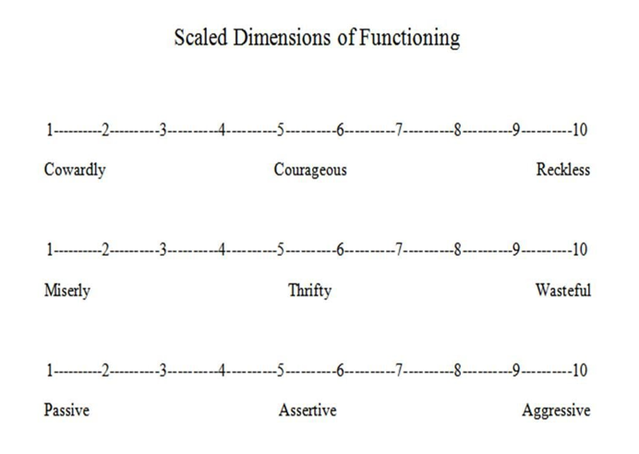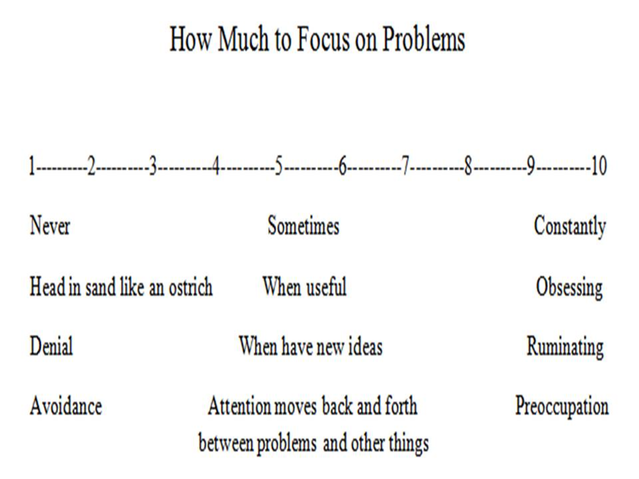Anxiety
How to Right-Size Your Anxiety
Think the best size is zero? Think again.
Posted January 31, 2021 Reviewed by Gary Drevitch
Most people who have experienced serious anxiety find it hard to believe that there could be anything good about it, but there is. If a genie ever emerges from a bottle and offers to make you anxiety-free for the rest of your life, don’t take him up on it until you consider this research finding: The only identifiable group of people who have practically no anxiety are psychopaths.
The unifying theme of this post is an idea traceable to Aristotle, Buddha, and Confucius and supported by a great deal of recent research: Effective psychological functioning usually involves some kind of moderate balance between opposite extremes (Shapiro, 2020a). This means most forms of dysfunction involve potentially effective ways of functioning that have gone too far.
The best way to understand this idea is to picture spectrums that show the full range of the dimension in question. Here are three classic examples.

Does this schema work for anxiety, too? Sure. Here is a simple version of the relevant spectrum:
1---------2---------3---------4---------5---------6---------7---------8---------9---------10
Severely Anxious Healthy Psychopathic
The Purpose of Anxiety
To understand this spectrum on a deeper level, we have to ask the evolutionary question: What is the adaptive function of anxiety? Why did it evolve, and what good does it do? The short answer is: plenty.
Anxiety is the emotion that drives the fight-or-flight response — a suite of psychobiological processes that gears us up for intense action. At lower levels of intensity, anxiety is the emotion that produces caution, vigilance, and conscientiousness.
True psychopathy is rare, and for research purposes it is combined with milder versions of itself—Antisocial Personality Disorder and the Conduct Disorders—to form a category called conduct disturbances. Most people with conduct disturbances have more than zero anxiety, but they have very little, so it is informative to compare them to people who have a lot.
Neuroscience research has found that, in a number of ways, anxiety disorders and conduct disturbances are opposites: One group has too much fear, the other too little. The research summarized below suggests these two forms of dysfunction represent opposite extremes of one continuum, the mid-range of which is associated with good mental health—and that includes having the right amount of fear. (See Shapiro, 2020b, for the references.)
Many people with anxiety disorders have an abnormally large and over-active amygdala, while many people with conduct disturbances have an abnormally small and under-active amygdala. Anxiety disorders are associated with overactivity of the autonomic nervous system and hypothalamic-pituitary-adrenal (HPA) axis. Conduct disturbances are associated with underactivity of the autonomic nervous system and HPA axis. The bloodstreams of anxious people are often flooded with adrenaline, cortisol, and other stress hormones, while the bloodstreams of conduct disordered people have abnormally low levels of stress-related hormones. Psychopaths, who exhibit the most extreme form of conduct disturbance, are sometimes described as “having ice water in their veins.”
Thus, the brains and bodies of anxious individuals are hair-triggered to overreact to possible threats, while the brains and bodies of conduct disordered individuals are under-responsive to threats of negative consequences; this is why these individuals repeatedly engage in risky behaviors, suffer bad outcomes, and don’t seem to learn from their experiences. Aristotle, Buddha, and Confucius were right.
Anxiety is an evolution-based response with adaptive value in situations involving danger or threat. In a way, anxiety disorders are too much of a good thing (which doesn’t mean they aren't miserable to experience).
The solution to the problem of anxiety is not elimination but right-sizing. Some people would do better with less anxiety, and some would do better with more. Anxiety becomes dysfunctional when it is excessive, but so do most traits, styles, and types of responses.
When anxious people learn to moderate their anxiety and limit it to appropriate situations, their liability becomes a strength. Positive qualities such as carefulness, preparedness, and prudence are fueled by situationally appropriate, mild anxiety. The next diagram illustrates this idea:

Anxiety and Avoidance
Anxiety disorders are maintained by avoidance. It is natural to avoid the things that make us anxious, but it is often counterproductive to do so.
Avoiding situations makes them more anxiety-producing. This makes us avoid them more, which then makes them more anxiety-producing. It’s a vicious cycle.
The way to learn how to cope with fears is to face them. Then we can learn either how to master the external situation or how to manage the internal experience that results, so we get used to it.
The way out of the anxiety cycle is called exposure, which is the opposite of avoidance. Exposure is the core of behavior therapy for anxiety. Exposure to what? The situations we fear.
Because of a fundamental conditioning process, our brains respond with less and less alarm to situations we encounter repeatedly, as long as we survive without serious harm. Of course we should not expose ourselves to genuinely dangerous situations, but anxiety itself, while uncomfortable, does not harm us; avoidance does.
Exposure should not be traumatic. For situations that are highly frightening, exposure should be incremental. As we gradually recondition our brain to tolerate these situations, we can feel the growth of our inner strength and toughness.
This strategy is effective both for fears that are concrete, like anxiety about heights or public speaking, and for fears that are abstract, like anxiety about intimacy or failure. Across all the situations that psychologists have studied, the formula is the same: Move into the frightening territory, feel the anxiety increase, survive, feel the anxiety decrease, move further in, and repeat.
One qualification is necessary: Avoidance of anxiety-producing situations is not always maladaptive—like most things, it can be good unless it goes too far. The spectrum method can be used to get a handle on avoidance in the same way it can be used to get a handle on anxiety.
Avoidance, denial, and defensiveness can be conceptualized as one end of a spectrum of orientations toward problems. The issue is how extensively to direct attention toward problems or away from them. Viewed this way, there is adaptive value in avoidance, up to a point, and past that point, avoidance is maladaptive. The next diagram can help people at both ends of this spectrum develop a more moderate, balanced position on this two-sided issue:

Mindfulness and Relaxation Exercises
Many studies have shown that relaxation and mindfulness exercises decrease anxiety in most people. Relaxation is the opposite of anxiety and, to a considerable extent, relaxation is a learnable skill that can be developed by practice. HeadSpace.com and Calm.com provide many different techniques that can be used for this purpose.
Anxiety is a future-oriented emotion. We feel anxious about bad things that haven’t happened yet. The great insight of mindfulness teachers is that filling our consciousness with awareness of the present moment provides relief from anxiety. There are a million bad things that could happen in the future, but we can almost always take refuge in the present, where things are generally OK. This is the power of now.
Cognitive Approaches
Thoughts about the future are just that—thoughts. In the cognitive approach, we reduce anxiety by changing the thoughts, speculations, and imaginings that produce it.
One approach is to look at the evidence in a fair, balanced way. When we are anxious, we selectively focus on evidence suggesting that something bad will happen and that we won’t be able to cope with it. When we also focus on evidence that the feared event might not happen and, if it does, we can cope with it, the future generally looks less dire. It looks better still when we consider evidence that various good things could also happen in the future.
Changing our thoughts in this way does not transform our picture of the future from terrifying to lovely; it transforms the picture from terrifying to complex, mixed, uncertain, and hopeful—in other words, realistic. Anxiety is not insanity—there are dangers and threats that we need to be aware of. Defocusing on the negative and distributing our attention more fairly moves us from the anxious end of the spectrum toward the middle, which right-sizes our anxiety. In the real world, this is the best we can do.
References
Shapiro, J. (2020a). Psychotherapeutic diagrams: Pathways, spectrums, feedback loops, and the search for balance. Amazon Digital Services.
Shapiro, J. (2020b). Finding Goldilocks: A guide for creating balance in personal change, relationships, and politics. Amazon Digital Services.




